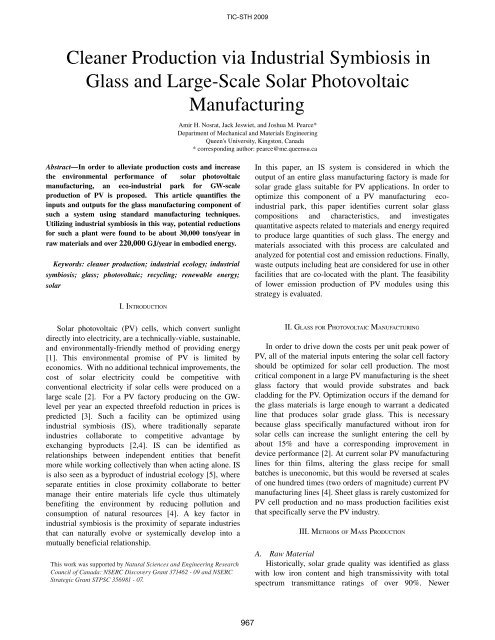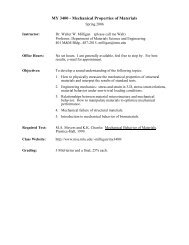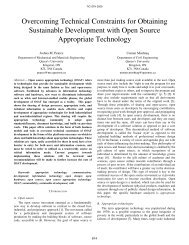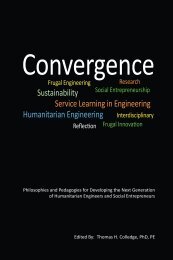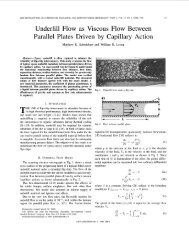Cleaner Production via Industrial Symbiosis in Glass - Materials ...
Cleaner Production via Industrial Symbiosis in Glass - Materials ...
Cleaner Production via Industrial Symbiosis in Glass - Materials ...
Create successful ePaper yourself
Turn your PDF publications into a flip-book with our unique Google optimized e-Paper software.
esearch and <strong>in</strong>dustrial practices suggest us<strong>in</strong>g morecomplex compositions that are specifically tailored for PVcell applications. One favorable composition based on apatent application suggests a total solar spectrumtransmittance of ~92% at 4 mm thick (wt.%6775 SiO 2 ,1020 Na 2 O, 515 CaO, 0.0010.05 Fe 2 O 3 ,
REFERENCES[1] J. Pearce, “Photovoltaics — A Path to Susta<strong>in</strong>able Futures,” Futures,vol. 34 (7), pp. 663–674, 2002.[2] J. Pearce, “<strong>Industrial</strong> <strong>Symbiosis</strong> for Very Large Scale PhotovoltaicManufactur<strong>in</strong>g”, Renewable Energy, vol. 33, pp. 1101–1108, 2008.[3] M.S. Keshner, R. Arya, “Study of potential cost reductions result<strong>in</strong>gfrom superlargescale manufactur<strong>in</strong>g of PV modules”, NREL, 2004.[4] M. R. Chertow, “<strong>Industrial</strong> symbiosis: literature and taxonomy,”Annu Rev Energy Environ, vol. 25, pp. 313337, 2000.[5] T. E. Graedel and B. R. Allenby, <strong>Industrial</strong> Ecology, 2 nd edition,.Prentice Hall 2003, 1995 AT&T; published by Pearson Education,Inc, Upper Saddle River N.J. USA.[6] Thomsen, et al., US Patent Application 11/373,490.[7] Edge, et al., US Patent Number 3884665.[8] A. Fluegel, “<strong>Glass</strong> viscosity calculation based on a global statisticalmodel<strong>in</strong>g approach,” <strong>Glass</strong> Technol.: Eur. J. <strong>Glass</strong> Sci. Technl., vol.48(1), pp. 1330, Feb. 2007[9] E. Worrell, C. Galitsky, E. Masanet, and W. Graus, “EnergyEfficiency Improvement and Cost Sav<strong>in</strong>g Opportunities for the <strong>Glass</strong>Industry,” U.S. EPA, March 2008[10] A. Fluegel, "Global Model for Calculat<strong>in</strong>g RoomTemperature <strong>Glass</strong>Density from the Composition." Journ. Amer. Ceram. Soc., vol.90(8), p 26222625, August 2008.[11] J. Pearce, S.J. Johnson, and G..B. Grant, “3Dmapp<strong>in</strong>g optimizationof embodied energy of transportation,” Resources, Conservation,and Recycl<strong>in</strong>g, vol. 51 (2), pp. 435453, 2007.[12] W. L<strong>in</strong>, Energy Conversion: New Research. New York: Nova SciencePublishers, 2008.[13] G.M. Ferreira, C. Chen, R.J. Koval, J.M. Pearce, R.W. Coll<strong>in</strong>s, andC.R. Wronski, "Optimization of protocrystall<strong>in</strong>e silicon ptype layersfor amorphous silicon nip solar cells", Journal of NonCrystall<strong>in</strong>eSolids, vol . 338340, pp. 694697, 2004.[14] A.S. Ferlauto, G.M. Ferreira, R.J. Koval, J.M. Pearce, C.R. Wronski,R.W. Coll<strong>in</strong>s, M.M. AlJassim, and K.M. Jones, "Evaluation ofCompositional Depth Profiles <strong>in</strong> Mixed Phase (Amorphous +Crystall<strong>in</strong>e) Silicon Films from Real Time SpectroscopicEllipsometry", Th<strong>in</strong> Solid Films, vol. 455456, pp. 665669, 2004.[15] J. Deng, J. M. Pearce, R. J. Koval, V. Vlahos, R.W. Coll<strong>in</strong>s, and C. R.Wronski, “Absence of carrier recomb<strong>in</strong>ation associated with thedefect pool model <strong>in</strong> aSi:H ilayers: evidence from current–voltagecharacteristics on pin and nip solar cells”, Applied PhysicsLetters, vol. 82, pp. 3023–3025, 2003.[16] S. Boots, Encyclopedia of Energy Technology and the EnvironmentVol. 4. New York: Wiley Interscience; 1995.[17] C. Papke, <strong>Glass</strong> Recycl<strong>in</strong>g and Reuse From Municipal Wastes. InRecycl<strong>in</strong>g Sourcebook, New York: Gale Research Inc., 1993.[18] GPI. <strong>Glass</strong> Conta<strong>in</strong>er Recycl<strong>in</strong>g Stays at Record High <strong>in</strong> 1995.Wash<strong>in</strong>gton, DC: <strong>Glass</strong> Packag<strong>in</strong>g Institute.[19] <strong>Glass</strong> Manufactur<strong>in</strong>g. World Bank Group, July 1998.[20] E.A. Vitunac, E.A. Zawadzki, US patent number 5350121.[21] Milne G, Readon C. In Your Home Technical Manual: Australia'sguide to environmentally susta<strong>in</strong>able homes. C. of Australia, 2005.[22] U.S. DOE, Energy and Environmental Profile of the <strong>Glass</strong> Industry.Wash<strong>in</strong>gton DC: Office of <strong>Industrial</strong> Technologies, DOE, 2002.[23] H. Pieper, “Der Heutige <strong>Glass</strong>chmelzofenbau – Herausforderung zurEnergiee<strong>in</strong>sparung und Umweltverträglichkeit” GlastechnischeBerichte , vol. 70 (8), pp.117124, 1997970


